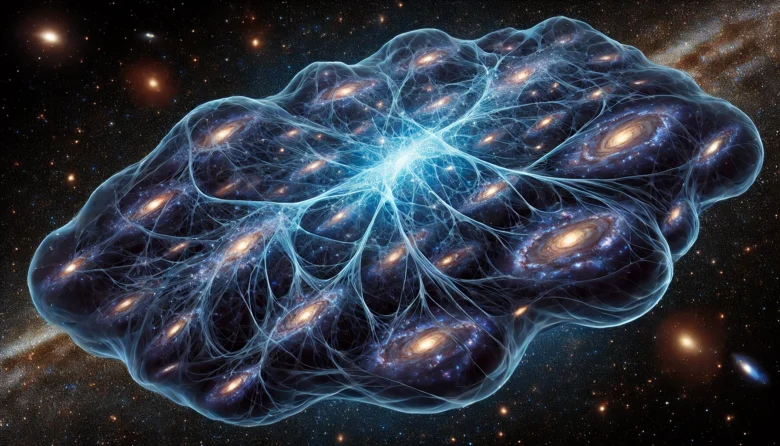Picture this: You’re looking up at the night sky, marvelling at the stars, planets, and galaxies that twinkle from afar. But what if I told you that all the stars, planets, and everything we can see with our eyes make up less than 5% of the universe? The rest is largely invisible to us, with a significant portion of it being something scientists call “dark matter.” In this blog, we’ll explore the mystery of dark matter, uncovering what we know so far and why it’s one of the most intriguing topics in modern physics.
What Is Dark Matter?
Let’s start with the basics. Dark matter is a type of matter that doesn’t emit, absorb, or reflect any light, making it completely invisible to our telescopes and other instruments that rely on electromagnetic radiation. Despite its elusiveness, dark matter is thought to make up about 27% of the universe. That’s a lot of stuff we can’t see!
So, how do we know it’s there? Scientists deduce the presence of dark matter based on its gravitational influence on visible objects. For instance, when astronomers observe galaxies, they notice that the stars at the edges of these galaxies move much faster than they should if only visible matter were present. This suggests that some unseen mass is exerting gravitational force, keeping these fast-moving stars from flying off into space. That unseen mass is what we call dark matter.

The Early Clues: How Dark Matter Was Discovered
The story of dark matter began in the 1930s when Swiss astronomer Fritz Zwicky made a startling observation. He observed the Coma Cluster, a collection of galaxies, and realized that the galaxies were moving at such high speeds that they should have drifted apart. However, they didn’t. Zwicky concluded that there must be some “missing mass” holding the cluster together, which he dubbed “dunkle Materie,” or dark matter.
Initially, Zwicky’s idea didn’t gain much traction, but the concept of dark matter started gaining momentum in the 1970s. American astronomer Vera Rubin observed something similar in the rotation curves of spiral galaxies. According to the laws of physics, stars further from the centre of a galaxy should move more slowly than those near the centre. Rubin discovered that stars on the outer edges of galaxies were moving just as quickly as those closer to the centre. This was another piece of evidence pointing to the presence of dark matter.
What Could Dark Matter Be Made Of?
Now that we know dark matter exists, the next big question is: What is it made of? This is where things get really mysterious because, despite decades of research, scientists still don’t know for sure. However, they have some theories.
A prominent theory suggests that dark matter might consist of Weakly Interacting Massive Particles (WIMPs). WIMPs are theoretical particles that interact with regular matter only through gravity and the weak nuclear force, making them incredibly difficult to detect. Despite numerous experiments designed to catch a glimpse of WIMPs, they have so far remained elusive.
Another candidate is axions, extremely light particles that could also make up dark matter. Unlike WIMPs, axions would interact even less with normal matter, making them even harder to detect. Researchers are currently using highly sensitive instruments to search for these particles, but so far, no definitive evidence has been found.
There’s also the possibility that dark matter could be composed of something entirely different, something beyond our current understanding of physics. This is part of what makes dark matter so exciting—it could lead to the discovery of entirely new physics.
The Hunt for Dark Matter: Experiments and Observations
The quest to understand dark matter has led scientists to design some of the most sophisticated experiments in history. A notable experiment is the Large Hadron Collider (LHC) at CERN (European Organization for Nuclear Research). The LHC is the world’s largest and most powerful particle accelerator, where scientists smash particles together at high speeds to see what happens. By studying these collisions, researchers hope to find clues about dark matter particles.
Another approach involves deep underground detectors, like the ones used in the Xenon1T experiment in Italy. These detectors are protected from cosmic rays and other background interference, making them perfect for observing rare interactions between dark matter and ordinary matter. Although the Xenon1T experiment has yet to detect dark matter directly, it has set the most stringent limits on the possible characteristics of dark matter particles.
In space, the Fermi Gamma-ray Space Telescope has been scanning the cosmos for high-energy gamma rays that might be produced when dark matter particles annihilate each other. While there have been some intriguing signals, nothing conclusive has been found yet.
Dark Matter and the Structure of the Universe
Dark matter doesn’t just influence the motion of stars within galaxies; it also plays a crucial role in the formation and structure of the universe. According to current models of cosmology, dark matter was essential in the formation of galaxies and galaxy clusters. In the early universe, dark matter acted as a gravitational scaffold around which normal matter could clump together to form stars and galaxies.
Without dark matter, the universe as we know it wouldn’t exist. In fact, computer simulations that include dark matter provide a much better match to the observed distribution of galaxies in the universe compared to simulations that only include visible matter. This underscores the importance of dark matter in shaping the cosmos.
One fascinating aspect of dark matter is that it doesn’t seem to clump together like regular matter. While stars, planets, and galaxies form dense structures, dark matter remains more spread out. This diffuse nature of dark matter makes it harder to study directly but also suggests that it plays a different role in the cosmos than the matter we’re familiar with.
https://www.youtube.com/watch?v=Ficdtx94BhE&pp=ygUVVW52ZWlsaW5nIERhcmsgTWF0dGVy
Case Study: The Bullet Cluster
Some of the strongest evidence for dark matter comes from studying the Bullet Cluster, a pair of galaxy clusters that collided around 3.7 billion light-years away. When these clusters collided, the normal matter in the clusters (which includes stars, gas, and dust) interacted, producing a shockwave that scientists could observe.
However, the dark matter in each cluster passed through the collision unaffected. By studying the Bullet Cluster, astronomers could see that most of the mass in the cluster wasn’t where the normal matter was concentrated but where the dark matter was. This provided strong evidence that dark matter exists and behaves differently from normal matter.
Conclusion
The mystery of dark matter continues to challenge and intrigue scientists. Although we’ve collected substantial evidence supporting the existence and significance of dark matter in the universe, its exact nature remains elusive. The ongoing hunt for dark matter is one of the most exciting areas of research in modern physics, with the potential to unlock new realms of understanding about the universe.
As we look to the future, new experiments, observations, and perhaps even breakthroughs in technology or theory may finally reveal what dark matter is. Until then, dark matter remains one of the universe’s greatest unsolved mysteries, a reminder of how much we still have to learn about the cosmos.
Author’s Note
Exploring the unknown is one of the greatest joys of science, and dark matter epitomizes that sense of mystery and discovery. I hope this blog has sparked your curiosity about the universe’s hidden components and inspired you to learn more about the fascinating world of physics.
G.C., Ecosociosphere contributor.





Comments
The enthusiasm I have for your work matches your own. Your visual presentation is refined, and the content you’ve authored is of a high caliber. Nevertheless, you appear to be uneasy about the possibility of delivering something that may cause unease. I agree that you’ll be able to address this concern promptly.
Your writing has a way of resonating with me on a deep level. It’s clear that you put a lot of thought and effort into each piece, and it certainly doesn’t go unnoticed.